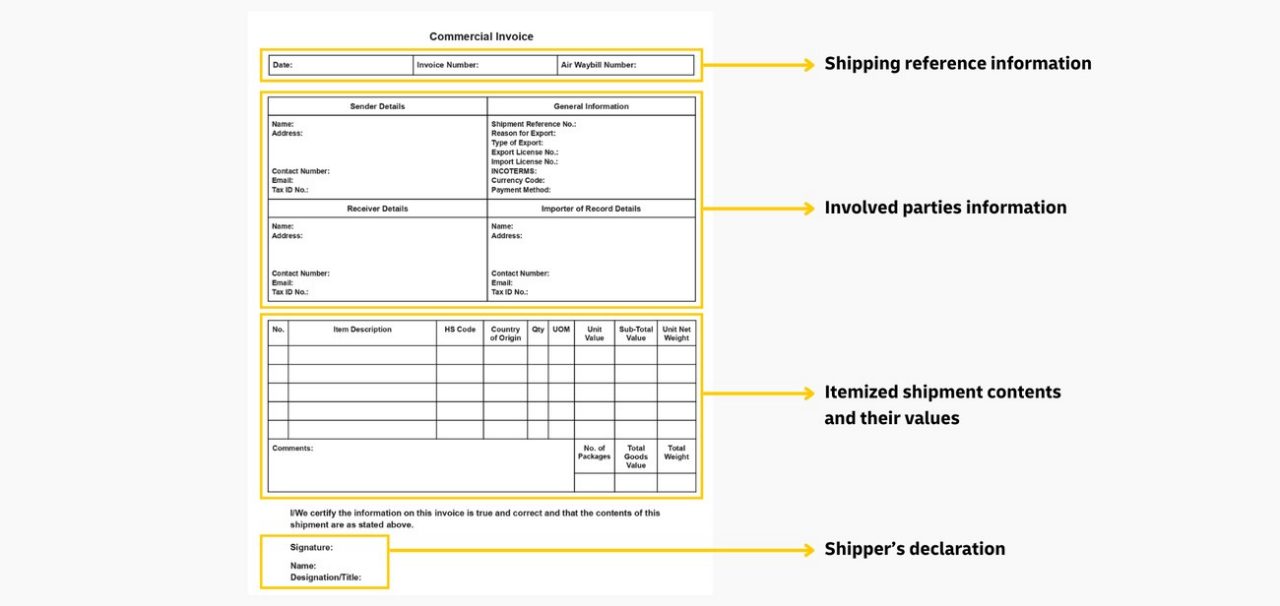
Every successful shipment leaving Pakistan starts with a crucial piece of paper: the commercial invoice.
Whether you’re exporting textiles or electronic parts, this document is the foundation of your international shipping journey. As such, getting it right is the first step to helping your shipment get through customs and reach its destination smoothly.
In this guide, we’ll guide you through how to create a commercial invoice for international shipping, setting the tone for a successful and compliant export experience.
What is a commercial invoice for shipping?
The commercial invoice for shipping is a legally binding document that serves as proof of sale to customs authorities in a foreign country. As such, it’s required for all international shipments possessing commercial value.
Customs authorities rely on the commercial invoice to assess the goods’ applicable duties and tax rates and determine if they are eligible for entry.
Consequently, this document must be filled meticulously and accurately to ensure your shipment can pass through customs without costly delay or rejection.
Essential information for your commercial invoice
A complete commercial invoice for international shipping must contain several key details to ensure smooth customs clearance.
Here’s a commercial invoice template to help you visualize its structure:

1. Sender and receiver details
The sender and receiver information on your commercial invoice for export serves to verify the legal parties involved in the sale and helps customs authorities contact the correct entities.
You will need the following information:
- Full names of the individual or company for the sender, receiver (consignee), and Importer of Record (if applicable).
- Addresses, including the physical street, unit number, city, country, and postal code.
- Contact information, including phone numbers and email addresses.
- Tax identification numbers, such as NTN, VAT, GST, or EORI, if applicable.
2. Shipment and transaction details
Your commercial invoice also documents the specifics of the transaction and the physical movement of the goods, including:
- A unique invoice number.
- The date of shipment, which reflects when the invoice was created or when the shipment was prepared.
- Air Waybill (AWB) or tracking number, a 10-digit tracking number assigned by the logistics company.
- Internal shipment reference number.
- Reason for export (for example, for sale, as a gift, or for repair and return).
- Type of export, which may be permanent or temporary (for instance, export for a trade show).
- Export or import license numbers where required to obtain regulatory approvals for restricted goods.
- Terms of Trade (Incoterms) to define who is responsible for costs, insurance, and risks at every point of the international shipping journey.
- Currency code used for the total transaction value.
- Payment method, such as Letter of Credit (L/C) or bank transfer.
3. Detailed goods description
This section of your commercial invoice contains details of the products being exported. Provide the following information to account for each item in the shipment:
- Item(s): Specify what the product is, including the brand name or model number if applicable.
- Materials: List the composition of the product, such as ‘100% cotton’, ‘stainless steel’, or ‘ceramic’.
- Intended use: State the function of the item, for example, ‘for laboratory testing’ or ‘men's casual wear’.
- Harmonized System (HS) code(s): This 6-digit code is mandatory for classification and assessing duties and taxes on the items in your international shipment.
- Country of origin: This refers to the country in which the goods were manufactured.
When filling out this section, avoid using vague terms like 'parts', 'samples', or 'electronics', as they prevent customs authorities from accurately determining the nature of the products.
This lack of specificity may result in the need for manual inspection and mandatory documentation requests, leading to costly customs delays and potential fines.
Instead, aim for clear and precise descriptions of each item in the shipment. For example, rather than simply stating ‘Apparel’, use ‘Men's knitted sweater, 80% wool/20% acrylic, for retail sale’.
4. Valuation and quantity
Accurate valuation and quantity details help customs authorities calculate and verify the duties and taxes on international shipments. To avoid clearance issues, include the following figures:
- Quantity of each item and unit of measure (for example, ‘pieces’, ‘kilograms’).
- Unit and sub-total value for each line item, ensuring the currency code is specified clearly.
- Total financial value of all items in the shipment.
- Unit and total weights (gross and net) of the items and entire shipment.
Common mistakes that lead to delays
In international shipping, even small errors on the commercial invoice can have big impacts on your business. As such, aim to avoid these common mistakes:
- Using vague descriptions: Refrain from using generic terms like 'samples' or 'clothing’. Instead, always provide specific and detailed descriptions of materials and intended use to ensure accurate classification.
- Undervaluing your goods: Declaring a value below the goods’ true commercial value may reduce duties, but it is an illegal practice that can lead to severe fines, penalties, and seizures by customs.
- Missing or incorrect HS Codes: Using the wrong Harmonized System (HS) code can trigger a mandatory customs review, so double-check it to ensure it matches your product classification.
- Inconsistent information: Discrepancies between the commercial invoice and other export documents required for custom clearance will raise red flags. As such, remember to verify that the quantities, weights, and values match the packing list and Air Waybill.
- Missing signature or date: The absence of a signature and date renders the commercial invoice invalid for customs clearance purposes, so ensure that it is properly signed and dated before shipment.
Partner with an expert for seamless shipments

A complete and accurate commercial invoice for international shipping is a non-negotiable document for swift customs passage.
However, with so many details to account for, it can be a challenge to ensure accuracy amidst daily operations and manufacturing schedules. As such, partnering with an experienced international shipping and logistics company like DHL Express can significantly ease this process.
For example, when you ship with DHL Express, you can simply enter your shipment details on the MyDHL+ platform, which will then generate a comprehensive commercial invoice for you to verify and use.
This powerful tool reduces the need to prepare the document from scratch, making the process faster and more accurate. Additionally, by ensuring compliance, you can avoid costly delays and ensure smooth fulfillment, solidifying your reputation as a reliable exporter.
Ready to simplify your shipping process and get it right every time? Open a business account with DHL Express and gain access to a powerful global network and suite of resources today.
